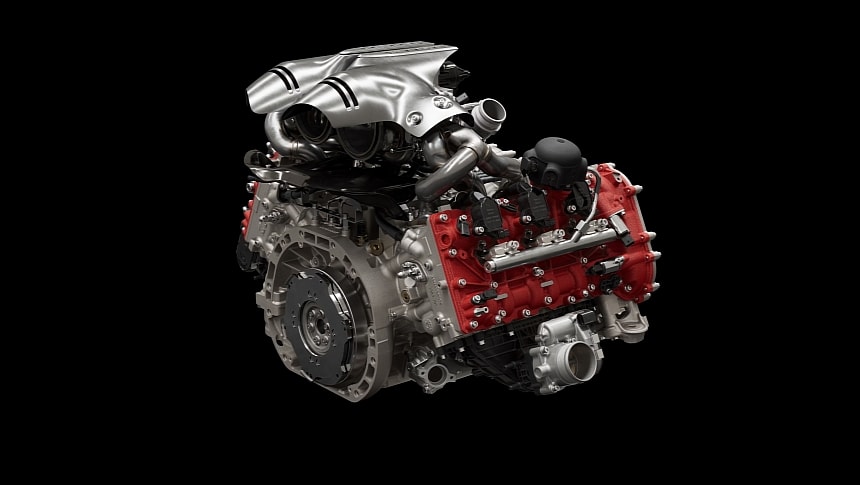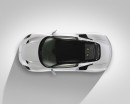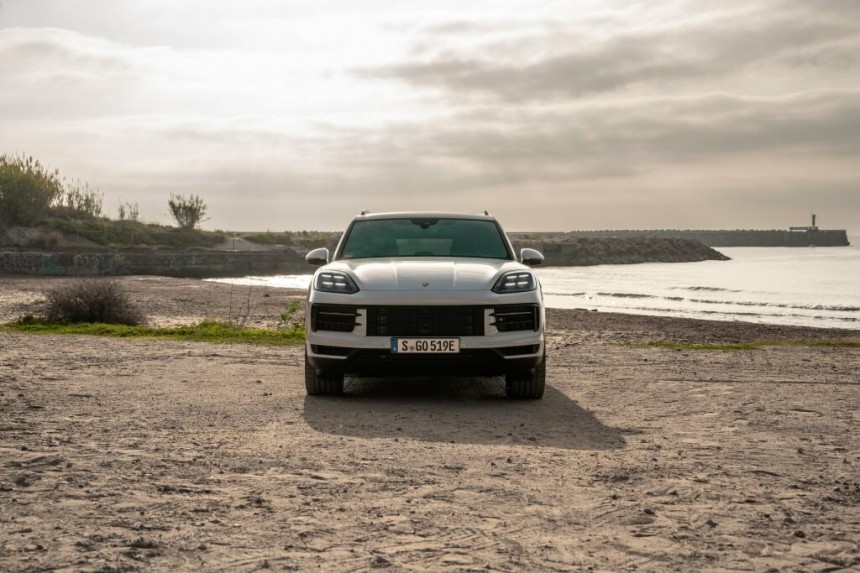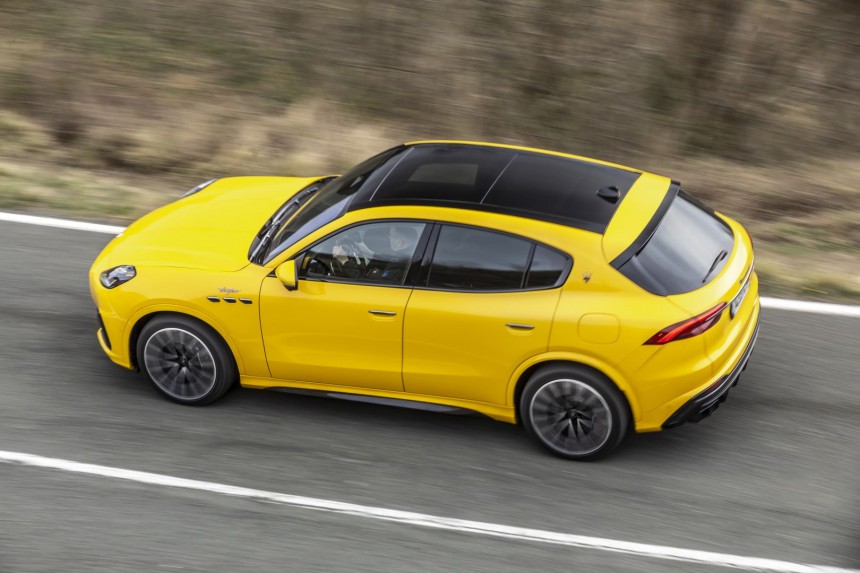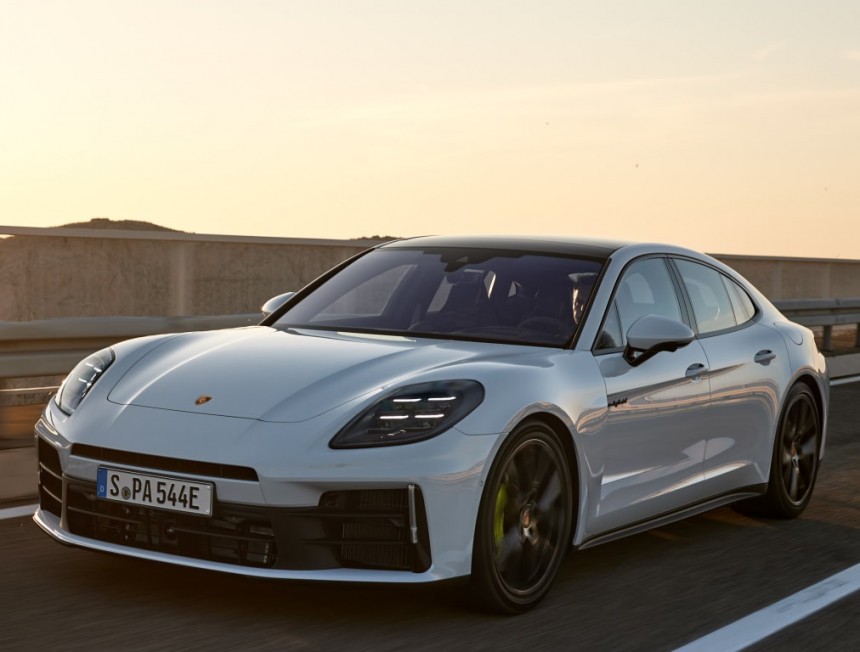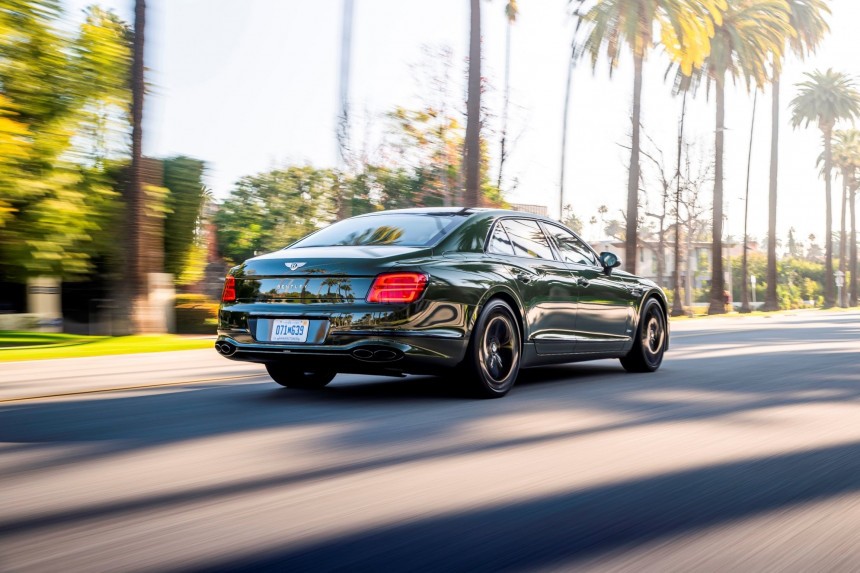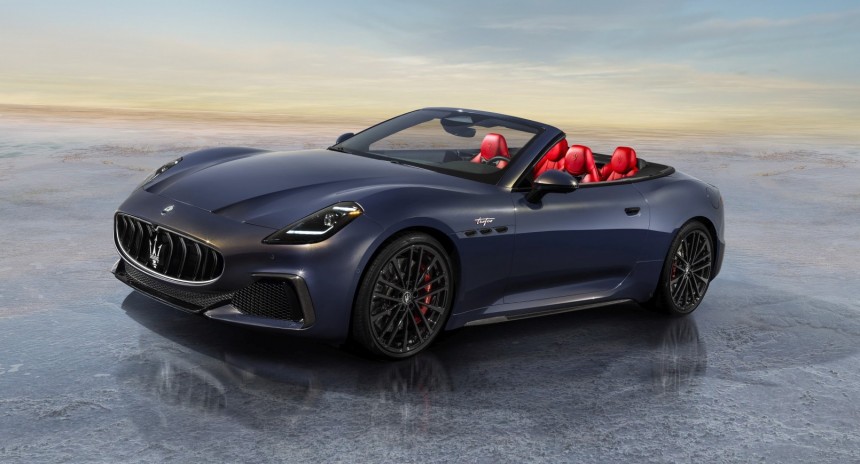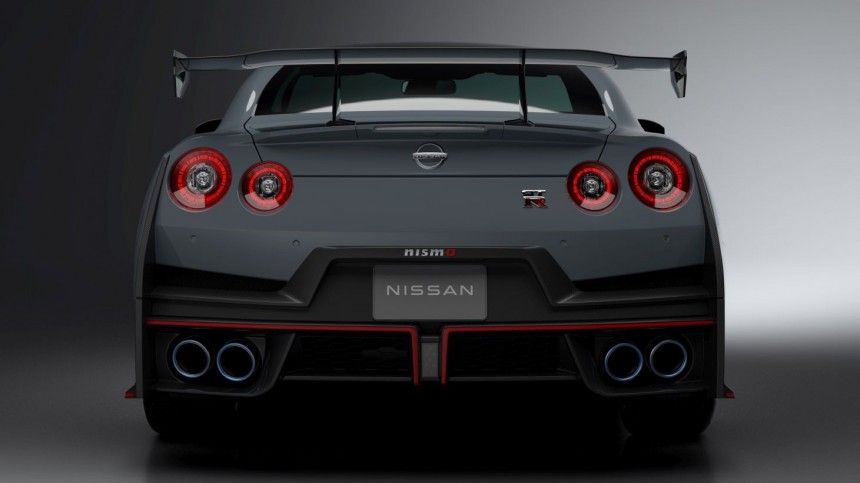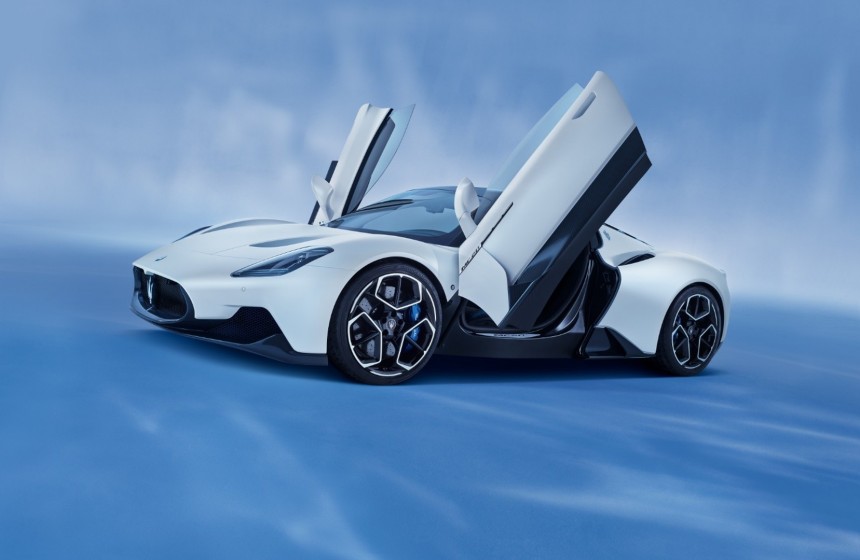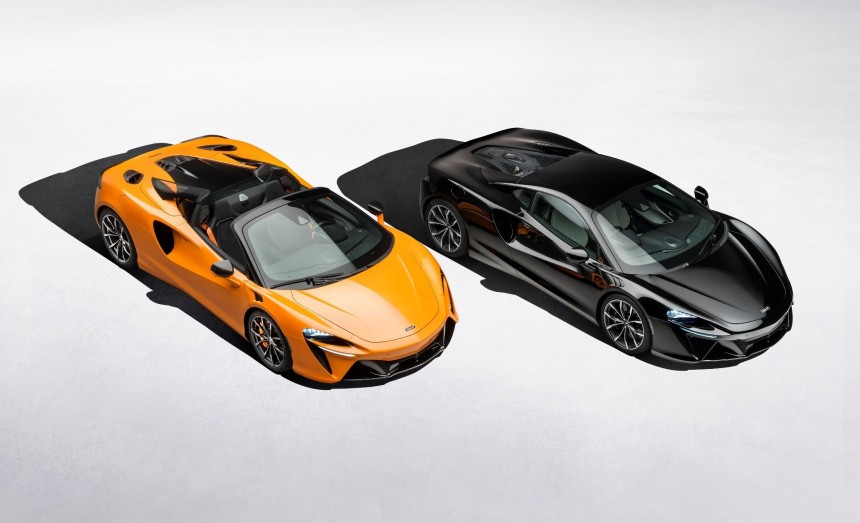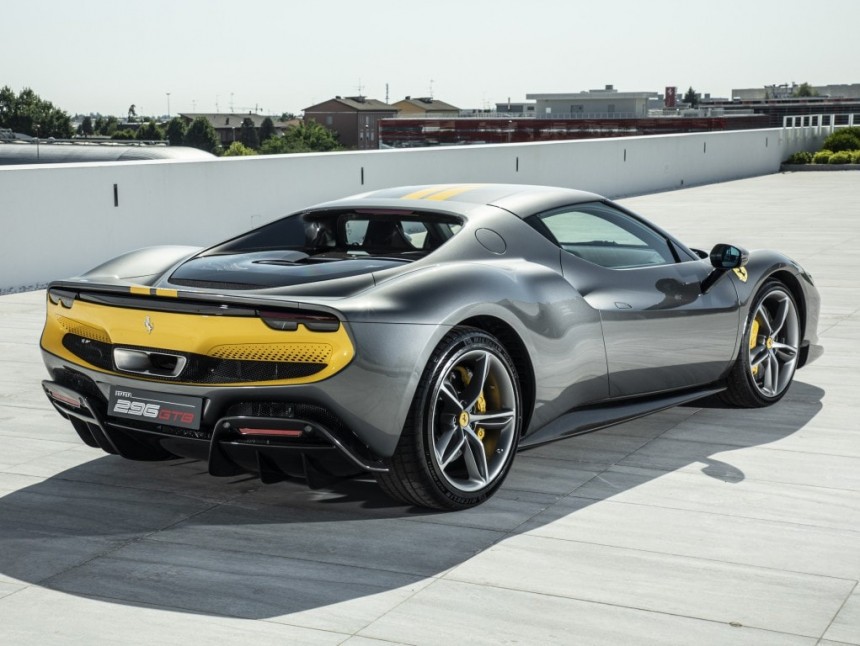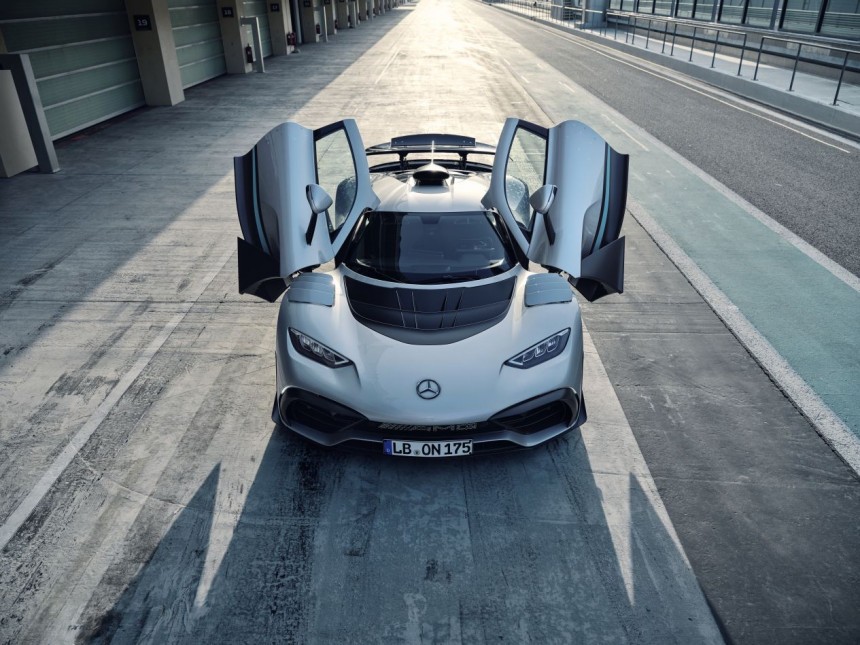Simply put, a V6 is a six-cylinder engine comprising two banks of cylinders arranged in a V formation. The 3.5-liter version of the Ford EcoBoost V6 features a 60-degree configuration, which is considered optimal in terms of balance when using a six-throw crankshaft (i.e., with individual crankshaft pins for the six cylinders to enable an even firing interval of 120 degrees).
The 1.6-liter turbo hybrid power unit adopted by Formula 1 teams in 2014, on the other hand, is a 90-degree sixer because the regulations say so. Regulations further dictate a three-throw crankshaft, therefore resulting in a stronger design. When it comes to extreme V angles, certain automakers come to mind, beginning with Volkswagen's 10.5- and 15-degree VR6 engines.
Wolfsburg's favorite son took inspiration from the Lancia V4 engine, which rolled out in 1922 with one cylinder head and 20 degrees between the banks. Once on the bleeding edge of all things engineering, Lancia introduced the first mass-production V6 in 1950 with a V angle of 60 degrees. However, the first V6 was made in 1906 by the Indianapolis-based Marmon Motor Car Company.
McLaren and Ferrari currently produce 120-degree V6 engines due to packaging and other pretty important reasons, including the center of gravity, the hot-vee configuration (i.e., turbos located in the valley between the cylinder heads), and because a cylinder detonates every 120-degree rotation of the crankshaft. With each pair of connecting rods sharing a crankshaft journal, this results in a shorter crank, which also means a stronger crankshaft.
Macca's and Fezza's 120-degree V6 lumps are some of the most powerful available in 2024. There are plenty other stupidly powerful V6 mills out there, which got us thinking – which are the most powerful V6 production cars as of 2024? Considering that the following top 10 starts with a 512-hp sport utility vehicle, it's pretty obvious that the V6 is in a good place despite increasingly stringent fuel economy and emission regulations in the US and the EU.
Although Porsche is synonymous with Neunelfers and their six-cylinder boxers, the German automaker from Zuffenhausen sells plenty more Macans and Cayennes. Unfortunately, the internal combustion-engined Macan is on its way out, and there's no fossil-fuel replacement in sight as Porsche aims to deliver more than 80 percent of its new vehicles with battery-electric drives in 2030.
The punchiest Macan today makes 434 horsepower, but in the absence of electrification, the Macan GTS plays second fiddle to the Cayenne S E-Hybrid. In the United States market, the plug-in hybrid SUV is advertised at $99,100 with 512 combined ponies, 4.4 seconds to 60 miles per hour (97 kilometers per hour) with the Sport Chrono Package, and 163 mph (262 kph) when equipped with summer tires.
Seriously good numbers for a vehicle that weighs 5,311 pounds (2,409 kilograms) and seats five. Cayenne S E-Hybrid is further listed with up to 55.1 cubic feet (1,560 liters) of cargo volume and a maximum towing capacity of 7,700 pounds (3,493 kilograms). The 2,995-cube sixer hiding underhood isn't a true Porsche design, but rather a joint effort from Volkswagen Group brands Audi and Porsche.
As you probably know by now, the Ferrari-developed Maserati V8 is no more. Instead, a 3.0-liter V6 dubbed Nettuno will have to make do with up to 621 mechanical horsepower in the MC20. But more on the indirect successor of the V12-powered MC12 later because Maserati continues to falsely advertise said V6 as being 100 percent Maserati.
Although the heads and compression ratio are unique to the House of the Trident, the Nettuno shares many traits with the F154 from Ferrari and the 690T from Alfa Romeo. From the V angle to the bore and stroke, firing order, maximum revs, cooling passages, and the location of the oil filter, it's pretty safe to assume that Maserati meant 15-ish percent instead of 100 percent. As opposed to 505 hp for the Alfa Romeo Stelvio Quadrifoglio's twin-turbo V6, the Stelvio-derived Maserati Grecale Trofeo belts out 523 horsepower at full chatter.
The lesser Modena and GT versions use a 2.0-liter turbocharged I4 that was introduced by what used to be Fiat Chrysler Automobiles back in 2016 with the 952-series Alfa Romeo Giulia. The Maserati Grecale Trofeo may not be as powerful as the 550-hp electric Folgore, but it's quicker to 60 miles per hour (3.6 seconds instead of 4.0 seconds) and nets a higher top speed (177 mph instead of 137 mph).
Remember the Cayenne S E-Hybrid we talked about earlier? As it happens, the Panamera 4S E-Hybrid is punchier still, for it features a different V6 engine and a different platform to boot. Closely related to the Bentley Flying Spur, the Panamera is rocking the MSB platform rather than the MLB. Der Modularer Standardantriebsbaukasten further underpins the Flying Spur's two-door sibling, whereas der Modularer Langsbaukasten is used by pretty much every internal combustion Audi from the A4 upward, the VW Touareg, Cayenne, Bentley Bentayga, and – of course – Lamborghini's Urus.
The S in 4S E-Hybrid probably stands for spicy, for the Panamera in this particular specification requires 3.5 seconds to hit 60 miles per hour. Top speed? Make that 180 miles per hour (290 kilometers per hour), thank you! Be that as it may, the Panamera 4S E-Hybrid isn't a one-trick pony. Like any Porsche, it rewards the driver with the kind of cornering prowess that makes the 4S E-Hybrid seem much lighter than its actual curb weight.
Tipping the scales at 5,068 pounds (2,299 kilograms), the liftback-style luxury sports sedan is this heavy due to the 25.9-kWh battery with a net capacity of 21.8 kilowatt hours. The electric motor is integrated into the dual-clutch transmission, which is far superior to the ZF 8HP torque-converter automatic transmission of the Cayenne.
Sporty continues to be a dirty word for the folks at Rolls-Royce Motor Cars, which is a bit ironic when you remember that the Ammirati & Puris advertising agency launched The Ultimate Driving Machine campaign for Rolls-Royce Motor Cars owner BMW AG back in 1974. This, in turn, puts Bentley at a huge advantage due to the rivaling brand's many successes in endurance racing.
The Continental GT-twinned Flying Spur may not be as charming as the Phantom, but it's much better in the twisties due to its Volkswagen Group-sourced platform, chamber air springs, and continuous damping control. The W12-powered Flying Spur Speed improves the recipe with a 48-volt electronic anti-roll system. Production of the Audi-developed W12 will end sometime in April 2024, leaving prospective customers to make a choice between twin-turbo V8 and a plug-in hybrid twin-turbo V6.
Manufactured in Crewe rather than Leipzig, the Flying Spur Hybrid is – no surprises here – a Panamera 4S E-Hybrid in a much fancier suit. Bentley's fanciest suit for the Flying Spur Hybrid is the Mulliner specification, which – as implied – offers virtually endless coachbuilding options. Certain people may not be amused by the idea of a six-cylinder Bentley, and yours truly much prefers the V8 as well. Nonetheless, the company's most successful factory racing car uses a six-pot mill.
It's hard to believe that Maserati produced the original GranTurismo for 12 years, but it's not as bad as Nissan with the GT-R. In any case, the Modenese automaker delivered a fantastic-looking second generation in 2022. Compared to the Grecale's four- and six-cylinder engines, the GranTurismo and GranCabrio are powered by the Nettuno twin-turbocharged V6 exclusively. The GC Modena is rated at 483 mechanical ponies in the US, whereas the GC Trofeo makes 542 horsepower.
The guttural howl of the old Ferrari-derived naturally aspirated V8 will be dearly missed, but let's try to look at the glass half full for a second. Not only does the Nettuno produce more torque (479 pound-feet or 650 Nm versus 384 pound-feet or 520 Nm) at lower engine speeds (3,000 versus 4,750 rpm), but it's more frugal as well (21 mpg or 11.2 l/100 km versus 16 mpg or 14.7 l/100 km).
Changes also include all-wheel drive instead of rear-wheel drive, making for a different experience behind the wheel. In addition to being more powerful and torquier than the Modena, the Trofeo further sweetens the deal with an electronically controlled limited-slip differential for the rear end.
Easily the oldest car here, the R35 entered series production at Nissan Motor Tochigi Plant in December 2007 for the 2009 model year. Exclusive of destination and handling, the 2009 Nissan GT-R was priced at $69,850 or $101,330 if we adjust for inflation. Good times, huh? The most affordable R35 for 2024 is a shocking $121,090 before taxes.
565 horsepower from the outset means that the standard GT-R should have made this list. For the sake of diversity, we decided to leave it out in favor of the 600-horsepower NISMO. Regardless of which R35 you prefer, the 3.8-liter V6 is a hand-assembled engine with plenty of tuning potential. Nissan calls it VR38DETT, with D standing for the dual overhead cams, E for electronic fuel injection, and TT for the IHI-supplied turbochargers. Wholly owned by Japan's IHI Corp., IHI Turbo America supplies FCA US LLC with twin-screw blowers for the soon-to-be-discontinued 6.2L Hellcat engine.
It wouldn't be wise to compare the straight-line capabilities of the GT-R NISMO to those of the Dodge Challenger SRT Demon 170, for the rear-drive muscle car is much quicker in the quarter. On a racetrack such as Laguna Seca or the Green Hell, the NISMO's handling-focused chassis would make easy work of the 1,025-horsepower muscle car.
Unpopular opinion, but the MC20 could have been designed with more attention to detail. The V6 engine isn't the problem, but rather the weight and interior. While the MC20 uses a carbon-fiber tub compared to the aluminum-intensive 296, the Maserati weighs 1,500 kilograms (3,307 pounds) dry as opposed to 1,470 (3,241) for the Ferrari.
How, in the name of all things holy, did the chief engineers sign off a combustion-only, carbon-tubbed supercar that's heavier than the plug-in hybrid 296? As for the interior, prospective customers will be disappointed by the Fiat and Alfa Romeo switchgear. Worse still, Maserati has the gall to charge over $200,000 when the Corvette Stingray Z51 matches the 0-60 time of the MC20.
In Mazzer's defense, it lapped the Nurburgring Nordschleife in 7:25 compared to 7:29 for the Stingray with the Z51 performance pack. Although the C8 is better value in all three forms (Stingray, E-Ray, and the high-revving Z06), nobody in their right mind would cross-shop C8 against MC20.
The Artura's M630 is the first engine McLaren has designed in-house. Its 120-degree V angle was locked in back in 2014, meaning that McLaren Automotive still produced the P1 when the decision was made to develop a V6 from the ground up rather than on an existing design. The M838T of the P1, by comparison, is derived from the Nissan VRH35L racing engine of the R390 GT1 endurance racecar.
McLaren had to push back deliveries for the Artura multiple times due to quality control issues. The Artura was also recalled twice in the United States (for high-pressure fuel pipe nuts that may loosen and a low-pressure fuel pipe that may detach). Better late than never, Macca finally made amends with extra quality control procedures and a plethora of hard-hitting updates for MY25.
The plug-in hybrid V6, for example, now makes 19 more horsepower. Better still, pre-2025 McLaren Artura owners will get the 19-horsepower bump free of charge in exchange for an hour of their precious time. Peak torque stays put, though, with McLaren quoting 531 pound-feet (720 Nm).
Sometimes referred to as Piccolo V12 for the V12-esque sounds it produces on wide-open throttle, the F163 is a marvel of engineering. Developed for both road-going applications and the Le Mans-winning 499P, the 3.0-liter unit develops 654 horsepower on its own in the 296 GTB and 296 GTS. The YASA axial flux electric motor tops 165 horsepower, with Ferrari promising 819 ponies on full song.
Astonishing may be the word you're looking for, and it gets even better. While plug-in hybrids from Mercedes-AMG and BMW M use all-wheel drive, the Prancing Horse of Maranello preferred RWD for the spiritual heir of the Dino 246 and the indirect replacement for the F8 series of midships.
Universally praised by motoring journalists, enthusiasts, and owners alike, 296 is only the start for the Italian automaker's first V6 intended for road cars. Ferrari has been spied testing a V6-engined hypercar at Maranello and Fiorano, with said hypercar due in 2025 as the new halo in the lineup. Although the LaFerrari sounds way nicer, the F250 will be quicker still at Fiorano. At the moment of writing, the lap record is held by the SF90 XX, which needs 1 minute 17 seconds compared to 1 minute 19 seconds for the LaF.
And now for the big one. The ONE may not be a true production car due to its F1-derived V6 engine and limited availability, but at the same time, it's a road-legal car sold by Mercedes-AMG rather than a tuner. The 1,049-hp thriller sports four electric motors: two for the front wheels, a motor generator unit-heat for the turbocharger, and a motor generator unit-kinetic for the crankshaft.
MGU-K juices up the high-voltage battery while braking and the MGU-H recovers waste energy from the exhaust. Said electric motors generate 360 kW or 483 horsepower, meaning that the 1.6-liter turbo V6 engine makes 566 horsepower. Owning a Formula 1-powered hypercar is not for the faint of heart, though. Not because one might run out of talent in the corners, but for different reasons.
Before refueling, owners have to depressurize the fuel tank by means of a switch located next to the pedal box. The small-displacement yet high-revving engine has to be rebuilt every 50,000 kilometers (circa 31,000 miles), and the regular service interval is 5,000 kilometers (around 3,100 miles). Oh, and by the way, Mercedes-AMG went for a pre-heated catalytic converter in order to meet emission regulations. TL;DR, the V6-powered ONE starts in electric mode, then fires up the sixer after the cat reaches the optimal temperature.
Wolfsburg's favorite son took inspiration from the Lancia V4 engine, which rolled out in 1922 with one cylinder head and 20 degrees between the banks. Once on the bleeding edge of all things engineering, Lancia introduced the first mass-production V6 in 1950 with a V angle of 60 degrees. However, the first V6 was made in 1906 by the Indianapolis-based Marmon Motor Car Company.
McLaren and Ferrari currently produce 120-degree V6 engines due to packaging and other pretty important reasons, including the center of gravity, the hot-vee configuration (i.e., turbos located in the valley between the cylinder heads), and because a cylinder detonates every 120-degree rotation of the crankshaft. With each pair of connecting rods sharing a crankshaft journal, this results in a shorter crank, which also means a stronger crankshaft.
Macca's and Fezza's 120-degree V6 lumps are some of the most powerful available in 2024. There are plenty other stupidly powerful V6 mills out there, which got us thinking – which are the most powerful V6 production cars as of 2024? Considering that the following top 10 starts with a 512-hp sport utility vehicle, it's pretty obvious that the V6 is in a good place despite increasingly stringent fuel economy and emission regulations in the US and the EU.
10. Porsche Cayenne S E-Hybrid (512 hp)
The punchiest Macan today makes 434 horsepower, but in the absence of electrification, the Macan GTS plays second fiddle to the Cayenne S E-Hybrid. In the United States market, the plug-in hybrid SUV is advertised at $99,100 with 512 combined ponies, 4.4 seconds to 60 miles per hour (97 kilometers per hour) with the Sport Chrono Package, and 163 mph (262 kph) when equipped with summer tires.
Seriously good numbers for a vehicle that weighs 5,311 pounds (2,409 kilograms) and seats five. Cayenne S E-Hybrid is further listed with up to 55.1 cubic feet (1,560 liters) of cargo volume and a maximum towing capacity of 7,700 pounds (3,493 kilograms). The 2,995-cube sixer hiding underhood isn't a true Porsche design, but rather a joint effort from Volkswagen Group brands Audi and Porsche.
9. Maserati Grecale Trofeo (523 hp)
Although the heads and compression ratio are unique to the House of the Trident, the Nettuno shares many traits with the F154 from Ferrari and the 690T from Alfa Romeo. From the V angle to the bore and stroke, firing order, maximum revs, cooling passages, and the location of the oil filter, it's pretty safe to assume that Maserati meant 15-ish percent instead of 100 percent. As opposed to 505 hp for the Alfa Romeo Stelvio Quadrifoglio's twin-turbo V6, the Stelvio-derived Maserati Grecale Trofeo belts out 523 horsepower at full chatter.
The lesser Modena and GT versions use a 2.0-liter turbocharged I4 that was introduced by what used to be Fiat Chrysler Automobiles back in 2016 with the 952-series Alfa Romeo Giulia. The Maserati Grecale Trofeo may not be as powerful as the 550-hp electric Folgore, but it's quicker to 60 miles per hour (3.6 seconds instead of 4.0 seconds) and nets a higher top speed (177 mph instead of 137 mph).
8. Porsche Panamera 4S E-Hybrid (536 hp)
The S in 4S E-Hybrid probably stands for spicy, for the Panamera in this particular specification requires 3.5 seconds to hit 60 miles per hour. Top speed? Make that 180 miles per hour (290 kilometers per hour), thank you! Be that as it may, the Panamera 4S E-Hybrid isn't a one-trick pony. Like any Porsche, it rewards the driver with the kind of cornering prowess that makes the 4S E-Hybrid seem much lighter than its actual curb weight.
Tipping the scales at 5,068 pounds (2,299 kilograms), the liftback-style luxury sports sedan is this heavy due to the 25.9-kWh battery with a net capacity of 21.8 kilowatt hours. The electric motor is integrated into the dual-clutch transmission, which is far superior to the ZF 8HP torque-converter automatic transmission of the Cayenne.
7. Bentley Flying Spur Hybrid (536 hp)
The Continental GT-twinned Flying Spur may not be as charming as the Phantom, but it's much better in the twisties due to its Volkswagen Group-sourced platform, chamber air springs, and continuous damping control. The W12-powered Flying Spur Speed improves the recipe with a 48-volt electronic anti-roll system. Production of the Audi-developed W12 will end sometime in April 2024, leaving prospective customers to make a choice between twin-turbo V8 and a plug-in hybrid twin-turbo V6.
Manufactured in Crewe rather than Leipzig, the Flying Spur Hybrid is – no surprises here – a Panamera 4S E-Hybrid in a much fancier suit. Bentley's fanciest suit for the Flying Spur Hybrid is the Mulliner specification, which – as implied – offers virtually endless coachbuilding options. Certain people may not be amused by the idea of a six-cylinder Bentley, and yours truly much prefers the V8 as well. Nonetheless, the company's most successful factory racing car uses a six-pot mill.
6. Maserati GranTurismo Trofeo and GranCabrio Trofeo (542 hp)
The guttural howl of the old Ferrari-derived naturally aspirated V8 will be dearly missed, but let's try to look at the glass half full for a second. Not only does the Nettuno produce more torque (479 pound-feet or 650 Nm versus 384 pound-feet or 520 Nm) at lower engine speeds (3,000 versus 4,750 rpm), but it's more frugal as well (21 mpg or 11.2 l/100 km versus 16 mpg or 14.7 l/100 km).
Changes also include all-wheel drive instead of rear-wheel drive, making for a different experience behind the wheel. In addition to being more powerful and torquier than the Modena, the Trofeo further sweetens the deal with an electronically controlled limited-slip differential for the rear end.
5. Nissan GT-R NISMO (600 hp)
565 horsepower from the outset means that the standard GT-R should have made this list. For the sake of diversity, we decided to leave it out in favor of the 600-horsepower NISMO. Regardless of which R35 you prefer, the 3.8-liter V6 is a hand-assembled engine with plenty of tuning potential. Nissan calls it VR38DETT, with D standing for the dual overhead cams, E for electronic fuel injection, and TT for the IHI-supplied turbochargers. Wholly owned by Japan's IHI Corp., IHI Turbo America supplies FCA US LLC with twin-screw blowers for the soon-to-be-discontinued 6.2L Hellcat engine.
It wouldn't be wise to compare the straight-line capabilities of the GT-R NISMO to those of the Dodge Challenger SRT Demon 170, for the rear-drive muscle car is much quicker in the quarter. On a racetrack such as Laguna Seca or the Green Hell, the NISMO's handling-focused chassis would make easy work of the 1,025-horsepower muscle car.
4. Maserati MC20 (621 hp)
How, in the name of all things holy, did the chief engineers sign off a combustion-only, carbon-tubbed supercar that's heavier than the plug-in hybrid 296? As for the interior, prospective customers will be disappointed by the Fiat and Alfa Romeo switchgear. Worse still, Maserati has the gall to charge over $200,000 when the Corvette Stingray Z51 matches the 0-60 time of the MC20.
In Mazzer's defense, it lapped the Nurburgring Nordschleife in 7:25 compared to 7:29 for the Stingray with the Z51 performance pack. Although the C8 is better value in all three forms (Stingray, E-Ray, and the high-revving Z06), nobody in their right mind would cross-shop C8 against MC20.
3. McLaren Artura (690 hp)
McLaren had to push back deliveries for the Artura multiple times due to quality control issues. The Artura was also recalled twice in the United States (for high-pressure fuel pipe nuts that may loosen and a low-pressure fuel pipe that may detach). Better late than never, Macca finally made amends with extra quality control procedures and a plethora of hard-hitting updates for MY25.
The plug-in hybrid V6, for example, now makes 19 more horsepower. Better still, pre-2025 McLaren Artura owners will get the 19-horsepower bump free of charge in exchange for an hour of their precious time. Peak torque stays put, though, with McLaren quoting 531 pound-feet (720 Nm).
2. Ferrari 296 (819 hp)
Astonishing may be the word you're looking for, and it gets even better. While plug-in hybrids from Mercedes-AMG and BMW M use all-wheel drive, the Prancing Horse of Maranello preferred RWD for the spiritual heir of the Dino 246 and the indirect replacement for the F8 series of midships.
Universally praised by motoring journalists, enthusiasts, and owners alike, 296 is only the start for the Italian automaker's first V6 intended for road cars. Ferrari has been spied testing a V6-engined hypercar at Maranello and Fiorano, with said hypercar due in 2025 as the new halo in the lineup. Although the LaFerrari sounds way nicer, the F250 will be quicker still at Fiorano. At the moment of writing, the lap record is held by the SF90 XX, which needs 1 minute 17 seconds compared to 1 minute 19 seconds for the LaF.
1. Mercedes-AMG ONE (1,049 hp)
MGU-K juices up the high-voltage battery while braking and the MGU-H recovers waste energy from the exhaust. Said electric motors generate 360 kW or 483 horsepower, meaning that the 1.6-liter turbo V6 engine makes 566 horsepower. Owning a Formula 1-powered hypercar is not for the faint of heart, though. Not because one might run out of talent in the corners, but for different reasons.
Before refueling, owners have to depressurize the fuel tank by means of a switch located next to the pedal box. The small-displacement yet high-revving engine has to be rebuilt every 50,000 kilometers (circa 31,000 miles), and the regular service interval is 5,000 kilometers (around 3,100 miles). Oh, and by the way, Mercedes-AMG went for a pre-heated catalytic converter in order to meet emission regulations. TL;DR, the V6-powered ONE starts in electric mode, then fires up the sixer after the cat reaches the optimal temperature.
